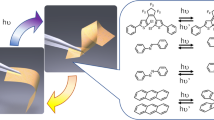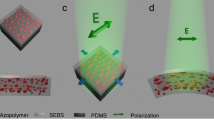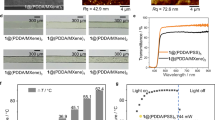Abstract
Photomechanical crystals composed of three-dimensionally ordered and densely packed photochromes hold promise for high-performance photochemical actuators. However, bulk crystals with high structural ordering are severely limited in their flexibility, resulting in poor processibility and a tendency to fragment upon light exposure, while previous nano- or microcrystalline composites have lacked global alignment. Here we demonstrate a photon-fuelled macroscopic actuator consisting of diarylethene microcrystals in a polyethylene terephthalate host matrix. These microcrystals survive large deformations and show a high degree of three-dimensional ordering dictated by the anisotropic polyethylene terephthalate, which critically also has a similar stiffness. Overall, these ordered and compliant composites exhibit rapid response times, sustain a performance of over at least hundreds of cycles and generate work densities exceeding those of single crystals. Our composites represent the state-of-the-art for photochemical actuators and enable properties unattainable by single crystals, such as controllable, reversible and abrupt jumping (photosalient behaviour).
This is a preview of subscription content, access via your institution
Access options
Access Nature and 54 other Nature Portfolio journals
Get Nature+, our best-value online-access subscription
$29.99 / 30 days
cancel any time
Subscribe to this journal
Receive 12 print issues and online access
$259.00 per year
only $21.58 per issue
Buy this article
- Purchase on Springer Link
- Instant access to full article PDF
Prices may be subject to local taxes which are calculated during checkout





Similar content being viewed by others
Data availability
The data that support the plots within this paper and other findings of this study are available at https://doi.org/10.25810/vm46-e710. Additional data related to this paper may be requested from the corresponding author.
References
Naumov, P., Chizhik, S., Panda, M. K., Nath, N. K. & Boldyreva, E. Mechanically responsive molecular crystals. Chem. Rev. 115, 12440–12490 (2015).
Sotome, H. et al. Cycloreversion reaction of a diarylethene derivative at higher excited states attained by two-color, two-photon femtosecond pulsed excitation. J. Am. Chem. Soc. 139, 17159–17167 (2017).
Sotome, H. et al. Geometrical evolution and formation of the photoproduct in the cycloreversion reaction of a diarylethene derivative probed by vibrational spectroscopy. ChemPhysChem 21, 1524–1530 (2020).
Morimoto, M. & Irie, M. A diarylethene cocrystal that converts light into mechanical work. J. Am. Chem. Soc. 132, 14172–14178 (2010).
Halabi, J. M., Ahmed, E., Sofela, S. & Naumov, P. Performance of molecular crystals in conversion of light to mechanical work. Proc. Natl Acad. Sci. USA 118, e2020604118 (2021).
White, T. J. & Broer, D. J. Programmable and adaptive mechanics with liquid crystal polymer networks and elastomers. Nat. Mater. 14, 1087–1098 (2015).
Kuenstler, A. S., Clark, K. D., Read de Alaniz, J. & Hayward, R. C. Reversible actuation via photoisomerization-induced melting of a semicrystalline poly (azobenzene). ACS Macro Lett. 9, 902–909 (2020).
Eisenbach, C. D. Isomerization of aromatic azo chromophores in poly(ethyl acrylate) networks and photomechanical effect. Polymer 21, 1175–1179 (1980).
Iwaso, K., Takashima, Y. & Harada, A. Fast response dry-type artificial molecular muscles with [c2]daisy chains. Nat. Chem. 8, 625–632 (2016).
Shibata, K., Muto, K., Kobatake, S. & Irie, M. Photocyclization/cycloreversion quantum yields of diarylethenes in single crystals. J. Phys. Chem. A 106, 209–214 (2002).
Turowska-Tyrk, I. & Trzop, E. Monitoring structural transformations in crystals. 6. The [4 + 4] photodimerization of 9-methylanthracene. Acta Crystallogr. B. Struct. Sci. Cryst. Eng. Mater. 59, 779–786 (2003).
Terao, F., Morimoto, M. & Irie, M. Light‐driven molecular‐crystal actuators: rapid and reversible bending of rodlike mixed crystals of diarylethene derivatives. Angew. Chem. Int. Ed. 51, 901–904 (2012).
Kitagawa, D. & Kobatake, S. Crystal thickness dependence of photoinduced crystal bending of 1,2-bis(2-methyl-5-(4-(1-naphthoyloxymethyl)phenyl)-3-thienyl)perfluorocyclopentene. J. Phys. Chem. C 117, 20887–20892 (2013).
Kobatake, S., Hasegawa, H. & Miyamura, K. High-convertible photochromism of a diarylethene single crystal accompanying the crystal shape deformation. Cryst. Growth Des. 11, 1223–1229 (2011).
Tong, F. et al. Photomechanically induced magnetic feld response by controlling molecular orientation in 9-methylanthracene microcrystals. Angew. Chem. Int. Ed. 57, 7080–7084 (2018).
Kobatake, S., Takami, S., Muto, H., Ishikawa, T. & Irie, M. Rapid and reversible shape changes of molecular crystals on photoirradiation. Nature 446, 778–781 (2007).
Dong, X. et al. Hybrid organic–inorganic photon-powered actuators based on aligned diarylethene nanocrystals. Chem. Mater. 31, 1016–1022 (2019).
Lan, T. & Chen, W. Hybrid nanoscale organic molecular crystals assembly as a photon-controlled actuator. Angew. Chem. Int. Ed. 52, 6496–6500 (2013).
Berman, A. et al. Biological control of crystal texture: a widespread strategy for adapting crystal properties to function. Science 259, 776–779 (1993).
Hooks, D. E., Fritz, T. & Ward, M. D. Epitaxy and molecular organization on solid substrates. Adv. Mater. 13, 227–241 (2001).
Varghese, S. et al. Epitaxial growth of light-responsive azobenzene molecular crystal actuators on oriented polyethylene films. J. Mater. Chem. C 8, 694–699 (2020).
Jean-Ruel, H. et al. Femtosecond dynamics of the ring closing process of diarylethene: a case study of electrocyclic reactions in photochromic single crystals. J. Phys. Chem. A 115, 13158–13168 (2011).
Ward, M. D. Bulk crystals to surfaces: combining X-ray diffraction and atomic force microscopy to probe the structure and formation of crystal interfaces. Chem. Rev. 101, 1697–1726 (2001).
Damman, P., Coppée, S., Geskin, V. M. & Lazzaroni, R. What is the mechanism of oriented crystal growth on rubbed polymer substrates? Topography vs epitaxy. J. Am. Chem. Soc. 124, 15166–15167 (2002).
Lansakara, T. I., Tong, F., Bardeen, C. J. & Tivanski, A. V. Mechanical properties and photomechanical fatigue of macro- and nanodimensional diarylethene molecular crystals. Nano Lett. 20, 6744–6749 (2020).
Dong, X. et al. Effects of template and molecular nanostructure on the performance of organic–inorganic photomechanical actuator membranes. Adv. Funct. Mater. 30, 1902396 (2019).
Guo, T., Zheng, X. & Palffy-Muhoray, P. Impedance matching in an elastic actuator. Soft Matter 17, 4191–4194 (2021).
Irie, M., Kobatake, S. & Horichi, M. Reversible surface morphology changes of a photochromic diarylethene single crystal by photoirradiation. Science 291, 1769–1772 (2001).
Ufimtsev, I. S. & Martinez, T. J. Quantum chemistry on graphical processing units. 1. Strategies for two-electron integral evaluation. J. Chem. Theory Comput. 4, 222–231 (2008).
Ufimtsev, I. S. & Martinez, T. J. Quantum chemistry on graphical processing units. 2. Direct self-consistent-field implementation. J. Chem. Theory Comput. 5, 1004–1015 (2009).
Ufimtsev, I. S. & Martinez, T. J. Quantum chemistry on graphical processing units. 3. Analytical energy gradients, geometry optimization, and first principles molecular dynamics. J. Chem. Theory Comput. 5, 2619–2628 (2009).
Timoshenko, S. Analysis of bi-metal thermostats. J. Opt. Soc. Am. 11, 233–255 (1925).
Nath, N. K. et al. Surface and bulk effects in photochemical reactions and photomechanical effects in dynamic molecular crystals. J. Am. Chem. Soc. 137, 13866–13875 (2015).
Koshima, H., Matsuo, R., Matsudomi, M., Uemura, Y. & Shiro, M. Light-driven bending crystals of salicylidenephenylethylamines in enantiomeric and racemate forms. Cryst. Growth Des. 13, 4330–4337 (2013).
Samanta, R. et al. Mechanical actuation and patterning of rewritable crystalline monomer–polymer heterostructures via topochemical polymerization in a dual-responsive photochromic organic material. ACS Appl. Mater. Interfaces 12, 16856–16863 (2020).
Li, C., Moon, J., Yun, J.-H., Kim, H. & Cho, M. Influence of external loads on structure and photoactuation in densely crosslinked azo-incorporated liquid crystalline polymers. Polymer 129, 252–260 (2017).
Li, M. H., Keller, P., Li, B., Wang, X. & Brunet, M. Light‐driven side‐on nematic elastomer actuators. Adv. Mater. 15, 569–572 (2003).
Ube, T., Takado, K. & Ikeda, T. Photomobile materials with interpenetrating polymer networks composed of liquid-crystalline and amorphous polymers. J. Mater. Chem. C 3, 8006–8009 (2015).
Lee, K. M. et al. Enhancement of photogenerated mechanical force in azobenzene‐functionalized polyimides. Angew. Chem. Int. Ed. 124, 4193–4197 (2012).
Wang, D. H., Wie, J. J., Lee, K. M., White, T. J. & Tan, L.-S. Impact of backbone rigidity on the photomechanical response of glassy, azobenzene-functionalized polyimides. Macromolecules 47, 659–667 (2014).
Zhou, H., Kuenstler, A. S., Xu, W., Hu, M. & Hayward, R. C. A semicrystalline poly (azobenzene) exhibiting room temperature light-induced melting, crystallization, and alignment. Macromolecules 55, 10330–10340 (2022).
Osaki, M. et al. Photoresponsive polymeric actuator cross-linked by an 8-armed polyhedral oligomeric silsesquioxane. Eur. Polym. J. 134, 109806 (2020).
Svanidze, A., Guo, T., Zheng, X. & Palffy-Muhoray, P. Light-induced stress and work in photomechanical materials. Phys. Rev. E 103, L051002 (2021).
Kitagawa, D. & Kobatake, S. Crystal thickness dependence of photoinduced crystal bending of 1,2-bis(2-methyl-5-(4-(1-naphthoyloxymethyl)phenyl)-3-thienyl) perfluorocyclopentene. J. Phys. Chem. C 117, 20887–20892 (2013).
Hirano, A., Hashimoto, T., Kitagawa, D., Kono, K. & Kobatake, S. Dependence of photoinduced bending behavior of diarylethene crystals on ultraviolet irradiation power. Cryst. Growth Des. 17, 4819–4825 (2017).
Irie, M., Fukaminato, T., Matsuda, K. & Kobatake, S. Photochromism of diarylethene molecules and crystals: memories, switches, and actuators. Chem. Rev. 114, 12174–12277 (2014).
Acknowledgements
This work was under the support of the Office of Naval Research through the MURI programme on Photomechanical Materials (ONR N00014-18-1-2624). Lawrence Livermore National Laboratory is operated by Lawrence Livermore National Security for the US Department of Energy, National Nuclear Security Administration under contract DE-AC52-07NA27344. M.H. was supported by the Air Force Office of Scientific Research through grant 21RT0488. We thank H. Zhao, Y. Hu and F. Tong for assistance with crystal analysis and helpful discussions.
Author information
Authors and Affiliations
Contributions
This project was under the supervision of R.C.H.; R.C.H. and C.J.B. proposed the conceptual idea; W.X. designed and conducted the major experiments; D.M.S., U.R. and T.J.M. conducted the theoretical calculations; H.Z., X.D. and M.H. were involved in X-ray characterization; all authors contributed to the analysis and interpretation of the results; and W.X. drafted the initial paper, which was revised by all authors.
Corresponding author
Ethics declarations
Competing interests
The University of Colorado Boulder has filed a US Patent Application (18/318,926, inventors: Wenwen Xu, Ryan C. Hayward) on the preparation of hybrid polymer/crystal photomechanical materials. The other authors declare no competing interests.
Peer review
Peer review information
Nature Materials thanks the anonymous reviewers for their contribution to the peer review of this work.
Additional information
Publisher’s note Springer Nature remains neutral with regard to jurisdictional claims in published maps and institutional affiliations.
Supplementary information
Supplementary Information
Supplementary Figs. 1–23, Tables 1–8, Notes 1–3, captions for Videos 1–4 and References.
Supplementary Video 1
A nylon ball is glued at the tip of an 11-μm-thick actuator. The actuator performs lifting and unlifting under alternating UV and green light.
Supplementary Video 2
The actuation of an 11-μm-thick actuator under 5 ms pulsed UV light. The video was recorded at 5,000 f.p.s. The playback speed is 30 f.p.s.
Supplementary Video 3
During the latent period of the photosalient 11 μm composite, the hind leg of the composite first slides and gets pinned on the ratchet surface to accumulate elastic strain energy. Quickly releasing the stored elastic energy results in fast jumping behaviour. Both the recording and playback speeds for this video are 60 f.p.s.
Supplementary Video 4
Right after the latent period, the composite quickly leaps towards the vertical wall. The composite can be reset by green light and can repeat the jumping behaviour. The video was taken at 4,000 f.p.s., and the playback speed is 30 f.p.s.
Rights and permissions
Springer Nature or its licensor (e.g. a society or other partner) holds exclusive rights to this article under a publishing agreement with the author(s) or other rightsholder(s); author self-archiving of the accepted manuscript version of this article is solely governed by the terms of such publishing agreement and applicable law.
About this article
Cite this article
Xu, W., Sanchez, D.M., Raucci, U. et al. Photo-actuators via epitaxial growth of microcrystal arrays in polymer membranes. Nat. Mater. 22, 1152–1159 (2023). https://doi.org/10.1038/s41563-023-01610-4
Received:
Accepted:
Published:
Issue Date:
DOI: https://doi.org/10.1038/s41563-023-01610-4
This article is cited by
-
Microcrystal actuator arrays see the light
Nature Materials (2023)



